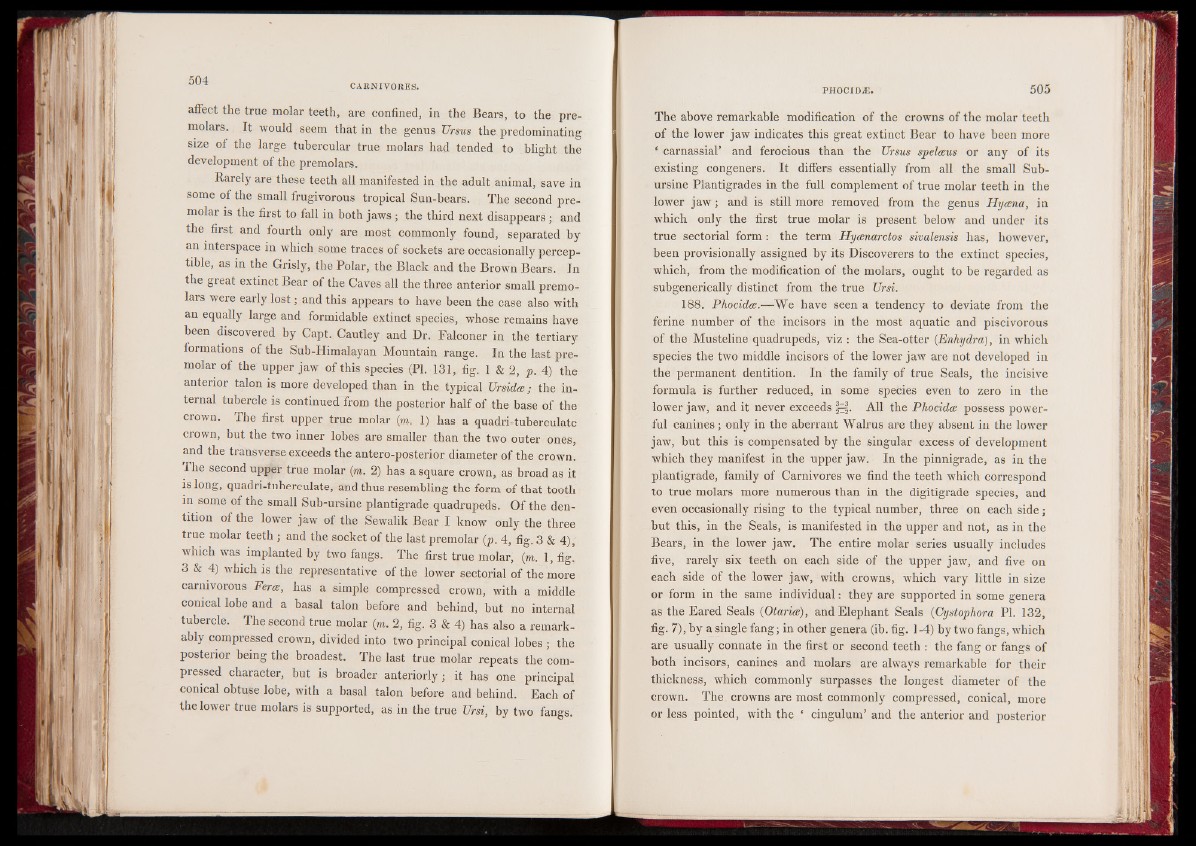
affect the true molar teeth, are confined, in the Bears, to the premolars.
It would seem that in the genus Ursus the predominating
size of the large tubercular true molars had tended to blight the
development of the premolars.
Rarely are these teeth all manifested in the adult animal, save in
some of the small frugivorous tropical Sun-bears. The second premolar
is the first to fall in both jaws ; the third next disappears ; and
the first and fourth only are most commonly found, separated by
an interspace in which some traces of sockets are occasionally perceptible,
as in the Grisly, the Polar, the Black and the Brown Bears. In
the great extinct Bear of the Caves all the three anterior small premolars
were early lost; and this appears to have been the case also with
an equally large and formidable extinct species, whose remains have
been discovered by Capt. Cautley and Dr. Falconer in the tertiary
formations of the Sub-Himalayan Mountain range. In the last premolar
of the upper jaw of this species (PI. 131, fig. 1 & 2, p. 4) the
anterior talon is more developed than in the typical Ursida; the internal
tubercle is continued from the posterior half of the base of the
crown. The first upper true molar (m. 1) has a quadri-tuberculate
crown, but the two inner lobes are smaller than the two outer ones,
and the transverse exceeds the antero-posterior diameter of the crown.
The second upper true molar (m. 2) has a square crown, as broad as it
is long, quadri-tuberculate, and thus resembling the form of that tooth
in some of the small Sub-ursine plantigrade quadrupeds. Of the dentition
of the lower jaw of the Sewalik Bear I know only the three
true molar teeth ; and the socket of the last premolar (p. 4, fig. 3 & 4),
which was implanted by two fangs. The first true molar, (m. 1, fig.
3 & 4) which is the representative of the lower sectorial of the more
carnivorous Fera:, has a simple compressed crown, with a middle
conical lobe and a basal talon before and behind, but no internal
tubercle. The second true molar (m. 2, fig. 3 & 4) has also a remarkably
compressed crown, divided into two principal conical lobes ; the
posterior being the broadest. The last true molar repeats the compressed
character, but is broader anteriorly; it has one principal
conical obtuse lobe, with a basal talon before and behind. Each of
the lower true molars is supported, as in the true Ursi, by two fangs.
The above remarkable modification of the crowns of the molar teeth
of the lower jaw indicates this great extinct Bear to have been more
‘ carnassial’ and ferocious than the Ursus spelæus or any of its
existing congeners. It differs essentially from all the small Sub-
ursine Plantigrades in the full complement of true molar teeth in the
lower jaw ; and is still more removed from the genus Hyoena, in
which only the first true molar is present below and under its
true sectorial form : the term Hyænarctos sivalemis has, however,
been provisionally assigned by its Discoverers to the extinct species,
which, from the modification of the molars, ought to be regarded as
subgenerically distinct from the true Ursi.
188. Phocidoe.—We have seen a tendency to deviate from the
ferine number of the incisors in the most aquatic and piscivorous
of the Musteline quadrupeds, viz : the Sea-otter (Enhydra), in which
species the two middle incisors of the lower jaw are not developed in
the permanent dentition. In the family of true Seals, the incisive
formula is further reduced, in some species even to zero in the
lower jaw, and it never exceeds All the Phocidoe possess powerful
canines ; only in the aberrant Walrus are they absent in the lower
jaw, but this is compensated by the singular excess of development
which they manifest in the upper jaw. In the pinnigrade, as in the
plantigrade, family of Carnivores we find the teeth which correspond
to true molars more numerous than in the digitigrade species, and
even occasionally rising to the typical number, three on each side ;
but this, in the Seals, is manifested in the upper and not, as in the
Bears, in the lower jaw. The entire molar series usually includes
five, rarely six teeth on each side of the upper jaw, and five on
each side of the lower jaw, with crowns, which vary little in size
or form in the same individual : they are supported in some genera
as the Eared Seals (Otarioe), and Elephant Seals (Cystophora PI. 132,
fig. 7), by a single fang ; in other genera (ib. fig. 1 -4) by two fangs, which
are usually connate in the first or second teeth : the fang or fangs of
both incisors, canines and molars are always remarkable for their
thickness, which commonly surpasses the longest diameter of the
crown. The crowns are most commonly compressed, conical, more
or less pointed, with the f cingulum’ and the anterior and posterior